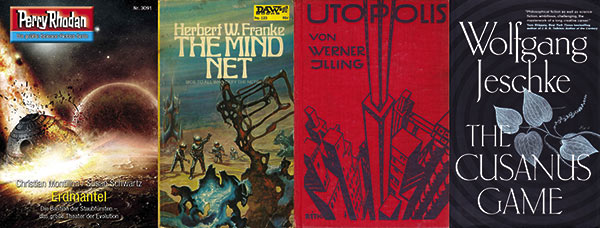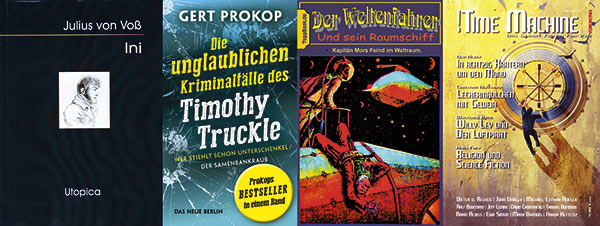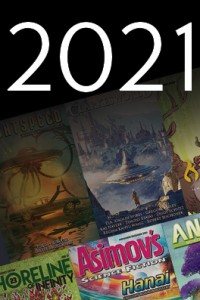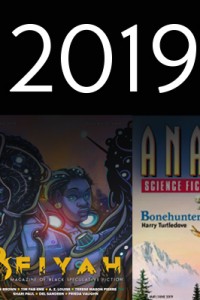SF in Germany

German SF looks back upon a history found in many other European countries: 17th and 18th-century proto-SF (such as Somnium [The Dream] by astronomer Johannes Kepler), a first novel meeting modern SF criteria published at the beginning of the 19th century (Ini. Ein Roman aus dem ein und zwanzigsten Jahrhundert [Ini. A Novel from the Twenty-First Century] by Julius von Voss in 1810 – eight years before Shelley’s Frankenstein), and then an era of novels about travelling to strange and alien territories and exploring them. German SF even has its own counterpart to H.G. Wells and Jules Verne, namely Kurd Laßwitz, whose deep humanity noticeably shapes his great novel Auf zwei Planeten in 1897 [Two Planets, 1971], and it also went through a successful period for dime novels afterwards (Der Luftpirat und sein lenkbares Luftschiff, 1908-1912 [“The Sky Corsair and his Dirigible Airship”], or Sun Koh – Der Erbe von Atlantis, 1933-1936 [“Sun Koh, the Heir of Atlantis”]).
The optimistic era of the Weimar Republic (1918-1933) and the ruinous effect on art during the Nazi regime (1933-1945) have both deeply influenced German SF authors. A “proletarian utopia” as described in Utopolis by Werner Illing in 1930 was banned a few years later, as was all socialist SF, and thus, German-language SF after WWII suffered from the suppression of its own traditions and developments in previous years. In consequence, literature from the allied powers dominated German SF in the respective occupation zones. American and British SF became role models for West German authors, while for the next four decades East German writers emulated the Russian speculative authors. Then the German reunification catapulted the two different modes of the genre to a shared market, and now, another three decades later, it is time to look at what has happened so far with SF in the German language.
Being genre literature, SF in Germany is strongly influenced by its various publishing media. In West Germany of the 1950s, many small local lending outlets for books emerged, the so-called “Leihbüchereien” [lending libraries], so that in the post-war period people could consume entertaining novels for low rental fees. For this purpose, specific “Leihbücher” [loan books] were printed on thick, cheap paper in a sturdy hardcover envelope, and for almost two decades they were competing with dime novels (known as “Heftromane”) in all popular genres, including the emerging SF genre. To escape the bad reputation of the dreary German novel, many German-speaking authors of Heftromane or Leihbücher used pen names with an English or American ring to them. SF could barely gain a foothold in the hardcover sector, but the rise of pocket books opened up the sales markets for genre literature, and so the publishers Goldmann and Heyne were regularly publishing SF works since 1961, however predominantly translated UK or US titles. In consequence, SF was finally recognized as a stand-alone genre.
In East Germany (German Democratic Republic), SF had significantly higher print runs (compared to West Germany) of hardcovers as well as paperback issues, and was extremely popular with the readers. Reprints and translations from the capitalist West were rare, and imports were prohibited, but SF works from Eastern European countries were translated instead. Thematically influenced by Russian authors, East German SF became more and more critical over the years, but this had to be done very covertly due to censorship and the threat of reprisals. However, by moving the plot to a distant planet or a future time, SF offered more opportunities to criticize local conditions than mainstream literature.
So, what happened with the two different modes of German SF after the reunification in 1989? It was quite disappointing, because the GDR-SF was simply swallowed up by the West-German SF market, and most of its independent character was lost. Only a few authors from the East were able to sustain their position on the book market, as the East German fans caught up with the previously banned West German and Anglophone authors, while the West German fans showed little interest in the GDR’s SF. At the same time, the boom in the genre shaping the ’80s ended, and fantasy novels and historical material displaced SF at the major publishing houses. The advancement of computer technology and digital printing opened opportunities for small publishers to produce low-number circulations, and the Internet also provided fitting distribution channels; thus, alternatives were created for aspiring SF authors. German-language SF gradually shifted to a large extent from dime novels and pocketbook imprints to small press publishers and, from this century onwards, also to the self-publishing scene. This is of particular interest for the SF short story market, as anthologies and collections kept selling worse compared to novels. Unfortunately, no professional SF magazine publishing high-quality short stories was ever able to establish itself in German-speaking countries over the years.
While the Leihbuch disappeared in the 1960s, the Heftroman sector boomed in many genres in West Germany and held its own against the emerging competition in pocketbooks. It became the new home of German-speaking authors. At the same time, it showed a tendency away from single novels, leaning towards endless series written by a team of authors. Among many others, one series stands out up to the present day: Perry Rhodan.
When Karl-Herbert Scheer and Walter Ernsting met in Munich in 1960 to create an epic space saga describing mankind’s journey to the stars, they had no idea that this series would still continue 60 years later. New episodes of Perry Rhodan have been published weekly since September 1961 in the 64-page dime novel format – volume 3,000 was published in February 2019. This is not only the longest story in the world (totaling more than 180,000 pages or 80,000,000 words), but also the most printed story (over a billion copies in total). In 1980s, up to four re-editions were published in parallel to first edition, a relaunch as Perry Rhodan Neo started in 2011, and there are countless offshoots ranging from single novels to trilogies or ten-volume short series such as Atlan, a spin-off in 850 issues. There are also comics and radio plays, loads of merchandising, and also translated editions, for example in the Netherlands, the Czech Republic, France, Japan, Brazil, and the USA.

Contrary to the extremely specific success story of the Perry Rhodan serial, it is hard to find a specific German aspect in SF per se by looking at the about 8,000 German SF titles published during last 30 years. The authors in Germany, Austria, and Switzerland do not address different topics than their colleagues in the US, the UK, France, Italy, or Spain. There are space operas and social fictions, cyberpunk stories, and steampunk novels, and stories where the heroes travel through space or time or rebel against future tyranny or suffer in a dystopian world. German readers can choose between light space adventures or highly sophisticated novels on philosophical discourses on far planets, humoristic stories, or epic future histories – thus the SF written originally in German does not really differ from translated SF. It is worth it to take a closer look at some authors and their specific oeuvre, though.
Herbert W. Franke started editing the hardcover series Zukunftsromane [Future Novels] at Goldmann in 1960 and shaped the German SF for almost five decades with his own very scientific and factual novels and short stories – for which the European SF Society granted him the European Grand Master Award in 2016. He dealt with the impact of science and often exotic environments on people as well as the interactions between technology and art, which he conveyed in his works in a somewhat dry, technical language, but with a wide range of specialist knowledge. His early works such as Das Gedankennetz, Der Orchideenkäfig and Zone Null have also been translated into English [as The Mind Net, The Orchid Cage and Zone Null].
Likewise, Wolfgang Jeschke was the editorial director of a SF imprint and an author at the same time: he was in charge of the Heyne SFF books from 1972 to 2002 and wrote six novels, half a dozen radio plays and two dozen short stories, and most of them won awards. His debut novel Der letzte Tag der Schöpfung [The Last Day of Creation] relocates the Cold War to the past via time travel, resulting in a fight for oil reserves, and his penultimate novel Das Cusanus-Spiel [The Cusanus Game], depicts a botanist’s journey to the 15th century and her influence on the speed of scientific developments. Both novels have been translated into several languages and contain Jeschke’s favorite subject, time travel and its paradoxes, but are also fine examples of his elaborate language and his strong humanist stance.
Carl Amery’s SF novels, such as Der Untergang der Stadt Passau [The Fall of the City of Passau] and An den Feuern der Leyermark [At the Campfires of Leyermark], show a lot of Bavarian local colour, but also the special humour of his homeland, and Reinmar Cunis addresses drugs (in Zeitsturm [Time Storm]) and environmental protection (in Wenn der Krebsbaum blüht [When the Cancer Tree is Blooming]) in a sensitive and intense way.
In East Germany at that time, the novels and stories by Hans Bach, Johanna & Günter Braun, Alexander Kröger, Carlos Rasch, Erik Simon, Angela & Karlheinz Steinmüller, and Michael Szameit were very much appreciated by fans of all ages. The funny short stories by Gert Prokop dealing with private investigator Timothy Truckle were especially popular (Wer stiehlt schon Unterschenkel? [Who Steals Lower Legs?] and Der Samenbankraub [The Sperm Bank Robbery]). In the west, Karl Michael Armer, Rainer Erler, Ronald M. Hahn, Thomas Mielke, Horst Pukallus, and Thomas Ziegler are among SF readers’ favorites.
For several years, Andreas Eschbach has been the German-speaking SF author with the highest print runs. In 1995, his first novel Die Haarteppichknüpfer [The Carpet Makers, also as The Hair-Carpet Weavers] was already a success; his time travel novel Jesus Video [Jesus Video Tape] was adapted for the screen. Each of his novels is devoted to a different topic or subgenre and is very well researched. At the same time, Eschbach has perfected his style and produces true page-turners, most recently in 2018 with NSA – Nationales Sicherheits-Amt [NSA – National Security Agency] an alternate history novel about digital data collection by the Nazi regime.
Andreas Brandhorst’s novels incorporate numerous ideas, even when he publishes two, sometimes three novels a year. With the six-volume Kantaki series, he achieved his breakthrough in 2004, and his space operas – such as Das Schiff (2014) [The Ship] or Omni (2015) [Omni] – have been unsurpassed for a decade.
Prior to German reunification, the married couple Angela & Karlheinz Steinmüller were among the most popular authors of the GDR-SF, especially with their novel Andymon from 1982. Since then, they have expanded their universe only through short stories and novelettes, all of which are collected in a new edition.
Other successful contemporary authors are Thomas Thiemeyer, Frank Schätzing, Kai Meyer, Marc-Uwe Kling, Michael Marrak, and Dietmar Dath, among others. German-language SF by women is rather rare, unfortunately. There are remarkable single novels by Heidrun Jänchen, Karla Schmidt, Judith Vogt, Claudia Kern, and Jacqueline Montemurri, but there are no female authors regularly publishing one or two novels per year.
German-speaking fandom has changed a lot over the years. It started in West Germany in the mid-1950s, when the first conventions took place, and the Science Fiction Club Deutschland (SFCD) was founded in 1955, but in the ’60s and ’70s there were political and content-relwated quarrels among the fans, clubs were continuously reorganized, and the creative forces were split up. In the ’70s and ’80s, the small clubs boomed, with countless fanzines, even in the GDR, where lack of resources and political surveillance made fannish life difficult. In the ’80s and ’90s, there were serious attempts to establish professional SF magazines, but only a few survived for several years, like Science Fiction Times or Alien Contact. Despite many changes in the media, the number of publications in the German-speaking area (SF originally in German or in translation) has remained roughly the same over the past five decades, between 400 and 500 titles a year, thus the need for information and overview kept the same. German SF fans can currently get information at DieZukunft.de, run by the SF editors of Heyne Verlag, and Tor-online.de, provided by the team of Fischer Tor. There are also internet newsgroups such as <sf-fan.de> and <deutsche-science-fiction.de> as well as the print magazines phantastisch!, Geek, and !Time Machine, or the online magazine Der Phantast. The semiprozines Exodus and Nova focus on short stories, while non-fiction books can be found at Memoranda Verlag. New magazines are also popping up, such as Queer*Welten in 2020.
The nomination lists of the German SF awards also may serve as reading recommendations: since 1980, the Kurd Laßwitz Preis has been awarded in up to eight categories every year. Like the Nebula Award, only SF professionals are allowed to nominate and vote. Since 1985, the SFCD has been awarding the only endowed German SF award, the Deutscher Science Fiction Preis, which is determined by a jury of club members. Other awards are the Phantastik-Preis der Stadt Wetzlar, the Deutscher Phantastik Preis, and the Seraph. Since each of the literary awards mentioned is set up differently in voting procedures and award categories, they complement each other wonderfully as reading recommendations for German-speaking SF fans.
–Udo Klotz & Christian Hoffmann
This report and more like it in the January 2021 issue of Locus.
 While you are here, please take a moment to support Locus with a one-time or recurring donation. We rely on reader donations to keep the magazine and site going, and would like to keep the site paywall free, but WE NEED YOUR FINANCIAL SUPPORT to continue quality coverage of the science fiction and fantasy field.
While you are here, please take a moment to support Locus with a one-time or recurring donation. We rely on reader donations to keep the magazine and site going, and would like to keep the site paywall free, but WE NEED YOUR FINANCIAL SUPPORT to continue quality coverage of the science fiction and fantasy field.
©Locus Magazine. Copyrighted material may not be republished without permission of LSFF.






